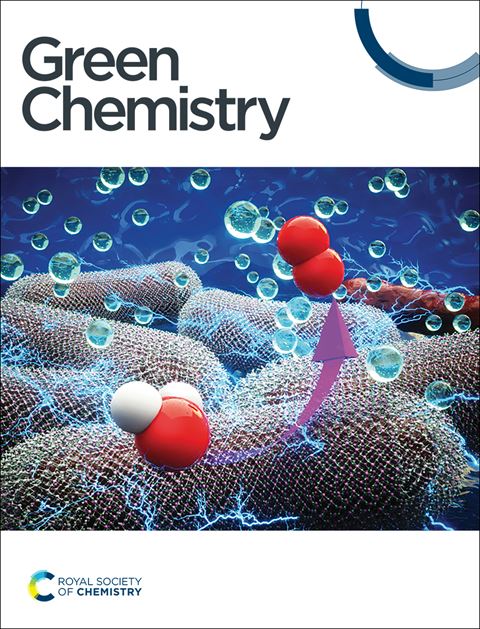Self-photosensitized cycloaddition induced synthesis of a high-density fuel with ultra-low freezing point using bulk bio-benzaldehyde and furans†
IF 9.2
1区 化学
Q1 CHEMISTRY, MULTIDISCIPLINARY
引用次数: 0
Abstract
Photocatalytic cycloaddition of biomass cycloolefins is a promising strategy for synthesizing high-density fuels; however, the current feedstocks are limited to cyclic ketenes that offer lower yields. Herein, we propose a universal self-photosensitized [2 + 2] cycloaddition approach to achieve ultra-low freezing point biofuels using biomass-derived bulk aromatic aldehydes, furans and olefins, which cannot be accomplished via thermal catalytic conversions. The triplet self-photosensitized mechanism was thoroughly demonstrated using a combination of monochromatic light excitation, triplet quenching, phosphorescence quenching, Stern–Volmer kinetic analysis and DFT calculations. Under room temperature, catalyst-free and solvent-free conditions, the optimal benzaldehyde conversion and cycloadduct selectivity reached 92.6% and 98.0%, respectively. This self-photosensitized [2 + 2] cycloaddition strategy could be expanded to various biomass-derived aromatic aldehydes, furans and olefins. In particular, the synthesized biofuel possessed a density of 0.805 g mL−1, an ultra-low freezing point of lower than −85 °C and an outstanding cryogenic kinematic viscosity of 28.7 mm2 s−1 at −60 °C, indicating its potential as a high-density and low-freezing-point fuel component and a low-freezing-point aerospace fuel additive. This work developed a versatile and eco-friendly route for photocatalytic biomass valorization to high-quality biofuels.

用散装生物苯甲醛和呋喃†自光敏环加成诱导合成超低凝固点高密度燃料
生物质环烯烃的光催化环加成是一种很有前途的高密度燃料合成方法。然而,目前的原料仅限于提供较低产量的环烯酮。在此,我们提出了一种通用的自光敏[2 + 2]环加成方法,利用生物质衍生的大量芳香醛、呋喃和烯烃来实现超低凝固点生物燃料,而这些都不能通过热催化转化来实现。通过单色光激发、三重态猝灭、磷光猝灭、Stern-Volmer动力学分析和DFT计算,全面论证了三重态自光敏化机理。在室温、无催化剂和无溶剂条件下,苯甲醛的最佳转化率和环加合物的最佳选择性分别达到92.6%和98.0%。这种自光敏[2 + 2]环加成策略可以扩展到各种生物质衍生的芳香族醛、呋喃和烯烃。特别是,合成的生物燃料具有0.805 g mL - 1的密度,低于- 85°C的超低冰点,在- 60°C时具有28.7 mm2 s - 1的低温运动粘度,表明其具有作为高密度低冰点燃料组分和低冰点航空航天燃料添加剂的潜力。这项工作为光催化生物质增值到高质量生物燃料开发了一种多功能和环保的途径。
本文章由计算机程序翻译,如有差异,请以英文原文为准。
求助全文
约1分钟内获得全文
求助全文
来源期刊

Green Chemistry
化学-化学综合
CiteScore
16.10
自引率
7.10%
发文量
677
审稿时长
1.4 months
期刊介绍:
Green Chemistry is a journal that provides a unique forum for the publication of innovative research on the development of alternative green and sustainable technologies. The scope of Green Chemistry is based on the definition proposed by Anastas and Warner (Green Chemistry: Theory and Practice, P T Anastas and J C Warner, Oxford University Press, Oxford, 1998), which defines green chemistry as the utilisation of a set of principles that reduces or eliminates the use or generation of hazardous substances in the design, manufacture and application of chemical products. Green Chemistry aims to reduce the environmental impact of the chemical enterprise by developing a technology base that is inherently non-toxic to living things and the environment. The journal welcomes submissions on all aspects of research relating to this endeavor and publishes original and significant cutting-edge research that is likely to be of wide general appeal. For a work to be published, it must present a significant advance in green chemistry, including a comparison with existing methods and a demonstration of advantages over those methods.
 求助内容:
求助内容: 应助结果提醒方式:
应助结果提醒方式:


